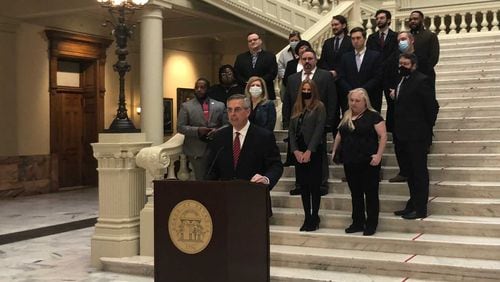Georgia is replacing a laggy statewide voter registration system that caused colossal lines during early voting in the 2020 election. The new technology could prevent similar waits in this year’s races for governor and the U.S. Senate.
Secretary of State Brad Raffensperger announced Wednesday that the state will partner with Salesforce, a San Francisco-based software company, to build a system that will store registration records for Georgia’s 7.7 million voters, check in early voters and process absentee ballot information.
The new system, nicknamed GARViS for the Georgia Registered Voter Information System, will take the place of the state’s ElectioNet technology that buckled under the weight of high turnout and unprecedented absentee ballot adoption in October 2020.
Wait times exceeded eight hours at the start of early voting before election officials and the state’s prior vendor, Louisiana-based Civix, added capacity to the system so it could handle the load. Election Day went more smoothly, with wait times averaging less than three minutes.
“This system has a lot higher capabilities, so we know that lines will be much shorter,” Raffensperger said, surrounded by county election directors at a Capitol press conference. “The average voter will see something that’s more responsive.”
Election officials said the new system will cost less than $3.5 million.
Other than a smoother voting experience, voters won’t see many changes, Raffensperger said. The registration system is used by election workers, and voters will still be able to find their voting location, sample ballot and absentee ballot status on the state’s My Voter Page at www.mvp.sos.ga.gov.
GARViS will be installed during an intense election year focused on voting rights following the passage of Georgia’s voting law, Senate Bill 202. The law limited ballot drop boxes, reduced the period to request absentee ballots, required new proof of voter ID for absentee voting and allowed state takeovers of county election boards.
“We recognize the challenges that happened during the 2020 election, and this is one of the attempts to be proactive prior to what will be a large election year,” Douglas County Elections Director Milton Kidd said. “We can all make the state of Georgia look great when the eyes of the nation are upon us.”
The American Civil Liberties Union of Georgia, which has at times been critical of the secretary of state’s office, praised Raffensperger’s decision to ditch ElectioNet, which has been in use in Georgia since 2013.
“The old system was glitchy,” said Vasu Abhiraman, senior policy counsel for the ACLU of Georgia. “This is going to be more user-friendly and enable counties to pay attention to voters instead of the IT system.”
The ElectioNet system will remain as a backup after the new system launches in March, ahead of the state’s May 24 primary.
Georgia relies on a live connection to its voter registration system during three weeks of early voting, when poll workers use laptops to check in voters by verifying their addresses and ensuring they haven’t already cast a ballot.
On election day, election officials check in voters with offline tablets called PollPads that are loaded with voter registration information.
If all goes well, voters will have nothing to complain about with the new system, said Lynn Bailey, who recently retired as Richmond County’s elections director.
“We all know that there were some significant delays, particularly in the area of advance voting, during the 2020 elections. This new system will help overcome that problem,” Bailey said. “We’re looking forward to a generally faster processing time.”
The voter registration system will be funded by a combination of state bonds and federal money provided by the Help America Vote Act. The secretary of state’s office has about $11 million left over from a $150 million bond appropriation in 2019 that purchased voting touchscreens, ballot printers and optical scanners.
The project wasn’t competitively bid. Instead, the secretary of state’s office chose Salesforce, which is an existing state subcontractor. Another company, MTX Group Inc., a technology consulting firm, will develop the user interface that election officials will use to interact with the system.
About the Author








